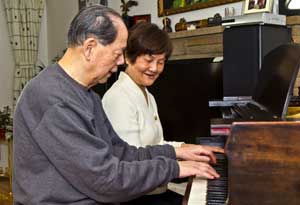For females, sexual dysfunction takes four main forms: arousal disorders, orgasmic disorders, dyspareunia and vaginismus.
 Arousal disorders are the result of inadequate sexual excitement
leading to insufficient vaginal lubrication. Some neurological disorders such as spinal cord injury, low levels of estrogen or substance use (e.g., medications, alcohol and narcotics) may cause arousal disorders. Altered genital sensation (e.g., numbness)
may be the result of diabetic neuropathy. Psychological causes include anxiety, stress or negative experiences, such as abuse.
Arousal disorders are the result of inadequate sexual excitement
leading to insufficient vaginal lubrication. Some neurological disorders such as spinal cord injury, low levels of estrogen or substance use (e.g., medications, alcohol and narcotics) may cause arousal disorders. Altered genital sensation (e.g., numbness)
may be the result of diabetic neuropathy. Psychological causes include anxiety, stress or negative experiences, such as abuse.
Arousal disorders may be treated by medical intervention for physical causes, sexual counseling aimed at reducing performance anxiety, and relationship counseling with the sexual partner. Options for increasing sexual communication and sexual pleasure include sensate focus exercises, and charting the personal extragenital matrix. These techniques focus on intimacy and exploring sensuality without sexual intercourse as the goal. Exploration can include different forms of touching (e.g., stroking, rubbing, squeezing, kissing, sucking, licking and nipping) and incorporate lotions, oils, powders, feathers, silk or sexual tools (e.g., vibrators.)
 Orgasmic disorders (anorgasimic/pre-orgasmic) result in difficulty
or inability to achieve orgasm. Orgasmic disorders may be caused by neurological impairment, insufficient clitoral or other forms of stimulation, and guilt or anxiety related to sexual pleasure. This dysfunction is often dependent on the situation;
for example, a woman may experience orgasm during masturbation, but not during intercourse.
Orgasmic disorders (anorgasimic/pre-orgasmic) result in difficulty
or inability to achieve orgasm. Orgasmic disorders may be caused by neurological impairment, insufficient clitoral or other forms of stimulation, and guilt or anxiety related to sexual pleasure. This dysfunction is often dependent on the situation;
for example, a woman may experience orgasm during masturbation, but not during intercourse.
Treatment options include counseling and education to counteract negative attitudes toward sexual activity, encouraging self-exploration and massage, educating the woman and/or her partner on the female sexual response, and providing information on alternative sexual options and use of devices (e.g., vibrators.) Vibrators provide intense stimulation of genital sensory nerves. This option may be especially helpful for women with MS, spinal cord injury or diabetes-induced neuropathy.
 Dyspareunia is painful intercourse or vaginal penetration.
The most common cause of dyspareunia is inadequate vaginal lubrication. Menopause is the most common reason for vaginal dryness in older women. It may also result from vaginal infections or sexually transmitted disease, pelvic inflammatory disease
or endometriosis, among other diseases.
Dyspareunia is painful intercourse or vaginal penetration.
The most common cause of dyspareunia is inadequate vaginal lubrication. Menopause is the most common reason for vaginal dryness in older women. It may also result from vaginal infections or sexually transmitted disease, pelvic inflammatory disease
or endometriosis, among other diseases.
Decreased vaginal lubrication can be relieved with water-based lubricants, such as KY Jelly, applied during sexual activity. (Vaseline or other petroleum-based products increase the chance of infection, and will deteriorate and reduce the effectiveness of condoms.) In some cases, hormone treatment may be used to improve vaginal lubrication. Counseling may address psychological causes (e.g., low self-esteem or anxiety) and education on sexual techniques, such as increased foreplay, for both partners may address technical causes.
 Vaginismus is the involuntary contraction of the pelvic muscles
surrounding the outer third of the vaginal barrel. This is commonly caused by a fear of vaginal penetration and is often related to a history of assault or abuse. In rare cases it is caused by neurological impairment.
Vaginismus is the involuntary contraction of the pelvic muscles
surrounding the outer third of the vaginal barrel. This is commonly caused by a fear of vaginal penetration and is often related to a history of assault or abuse. In rare cases it is caused by neurological impairment.
It can be treated through the use of graduated plastic vaginal dilators, sexual activities in which the woman is in control or on top, and counseling focused on previous assault or abuse.